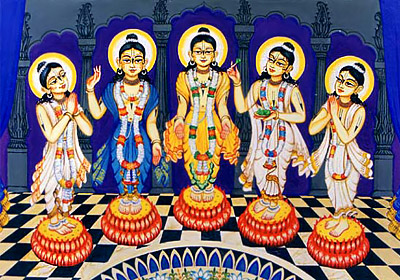 In Gaudiya Vaishnavism Pancha Tattva is believed to have incarnated on Earth as five people in the late 15th century. Those five people are Chaitanya Mahaprabhu, Nityananda Prabhu, Advaita Acharya, Gadadhara Pandita and Srivasa Thakura. They were responsible for spreading Hare Krishna mantra as well as Bhakti to Krishna throughout India.
In Gaudiya Vaishnavism Pancha Tattva is believed to have incarnated on Earth as five people in the late 15th century. Those five people are Chaitanya Mahaprabhu, Nityananda Prabhu, Advaita Acharya, Gadadhara Pandita and Srivasa Thakura. They were responsible for spreading Hare Krishna mantra as well as Bhakti to Krishna throughout India.
Chaitanya is said to be Krishna Himself. Nityananda is considered as Lord Krishna`s first personal expansion. Advaita Acharya is a combined embodiment of Lord Vishnu & Lord Shiva. Gadadhara Pandit is an incarnation of Lord Krishna`s internal energy. Srivasa is a pure devotee of Lord Krishna.
Within the Gaudiya Vaishnavism, a mantra was formed from the names of the five members of the Pancha Tattva. It is often sung as a means of devotional worship. This mantra is chanted prior to the Hare Krishna mantra. Its followers believe that this is the most merciful mantra.
This article is a stub. You can enrich by adding more information to it. Send your Write Up to content@indianetzone.com




















